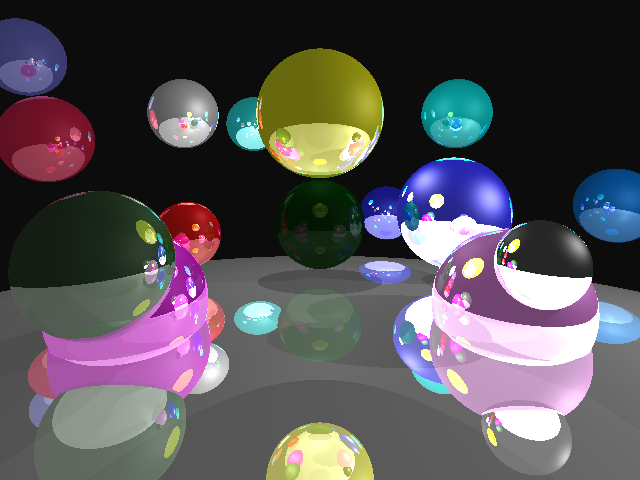In this assignment I was tasked with implementing a simple ray-tracer capable of rendering scenes of spheres lit by light sources.
In the previous homework, we implemented a parser for a simple scene file, the outline of the tracing code was already implemented. Additionally, the previous homework was written in c++.
I am not super fond of C++ for many reasons. For one, I think it’s bloated, each iteration of the C++ standard may be an improvement but keeping backwards compatibility creates about a million different ways to do the same thing. Furthermore, the c++ standard library is almost unreadable - I like to understand what the functions i’m calling do. Also, the compatibility with C introduces the familiar footguns of C (macros and more), with the additional footguns of C++. I could go on but I’ll spare your time.
For these reasons, I decided write the raytracer in zig⚡.
Some things that I like about zig:
- No hidden control flow.
- No hidden memory allocations.
- No preprocessor, no macros.
- C interop
Rant over.
To start, I reimplemented the scene parser in zig.
First we need a scene struct:
pub const Scene = struct {
// Camera properties
camera_pos: Vec3 = vec3.zero,
camera_fwd: Vec3 = Vec3{ 0, 0, -1 },
camera_up: Vec3 = Vec3{ 0, 1, 0 },
camera_right: Vec3 = Vec3{ -1, 0, 0 },
camera_fov_ha: f32 = 45,
film_resolution: struct { u16, u16 } = .{ 640, 480 },
output_image: [:0]const u8 = "raytraced.bmp",
spheres: std.ArrayList(Sphere),
background: Vec3 = Vec3{ 0, 0, 0 },
lights: std.ArrayList(Light),
max_depth: u16 = 5,
}
Oh, and our Vec3 type:
pub const Vec3 = @Vector(3, f64);
Then can build up our scene by looping over each line, switching on the command, and parsing the values.
switch (command.?) {
.camera_pos => scene.camera_pos = try parseVec3(vals),
.camera_fwd => scene.camera_fwd = try parseVec3(vals),
.camera_up => scene.camera_up = try parseVec3(vals),
.camera_fov_ha => scene.camera_fov_ha = try std.fmt.parseFloat(f32, vals),
...
Now that we have built our scene, we need to trace some rays. I copied the example in HW3 over to zig.
for (0..img_width) |i| {
for (0..img_height) |j| {
const f_i: f32 = @floatFromInt(i);
const f_j: f32 = @floatFromInt(j);
const u: f32 = f_half_w - @as(f32, @floatFromInt(img_width)) * (f_i + 0.5) * inv_img_width;
const v: f32 = f_half_h - @as(f32, @floatFromInt(img_height)) * (f_j + 0.5) * inv_img_height;
const p: Vec3 = s.camera_pos - vec3.splat(d) * s.camera_fwd + vec3.splat(u) * s.camera_right + vec3.splat(v) * s.camera_up;
const ray_dir: Vec3 = vec3.unit(p - s.camera_pos);
for (s.spheres.items) |sphere| {
const hit = raySphereIntersect(s.camera_pos, ray_dir, sphere);
const color = if (hit) Vec3{ 1, 1, 1 } else Vec3{ 0, 0, 0 };
output_img.setPixel(@intCast(i), @intCast(j), color);
}
}
}
And we get some images! 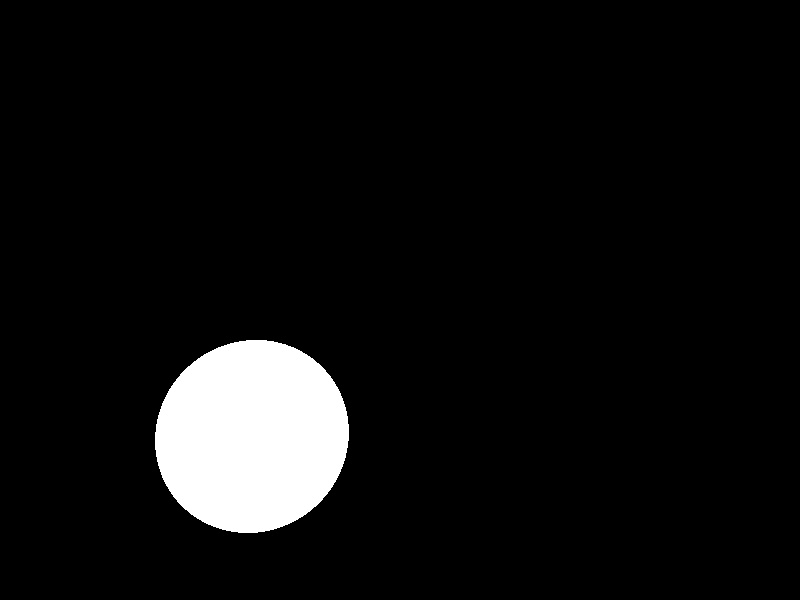
Okay we are now at the same spot as HW3.
To receive full credit for this assignment I needed to complete 10 of the following, with the underlined being required.
Scene Setup:
- Camera placement, film resolution, aspect ratio
- User specified background colors
- UI + OpenGL output
- BMP or PNG output
Primitives:
- Spheres
- Difference/Intersection of spheres (Constructive Solid Geometry)
Lighting:
- Ambient lights
- Point light sources
- Shadows
- Multiple light sources
- Directional light sources
- Spot light sources
Sampling:
- Basic Sampling
- Jittered Supersampling
- Adaptive Supersampling
- Motion Blur
- Depth of Field
Materials:
- Color & Specularity (Phong Lighting Model)
- Refraction
- Reflection
We already have a few complete by copying the starter code from HW3.
We can change the camera placement: 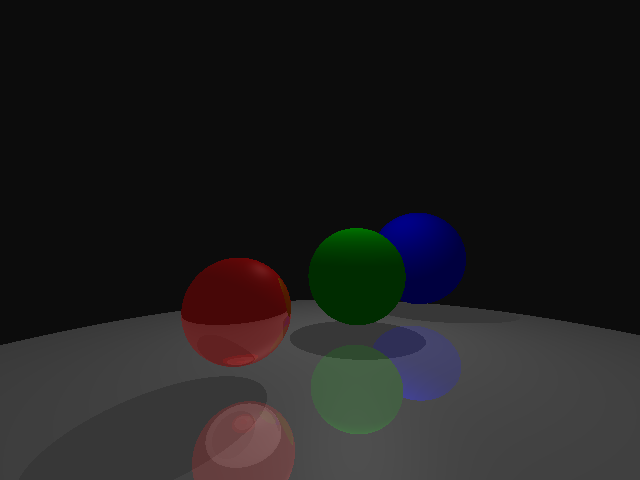
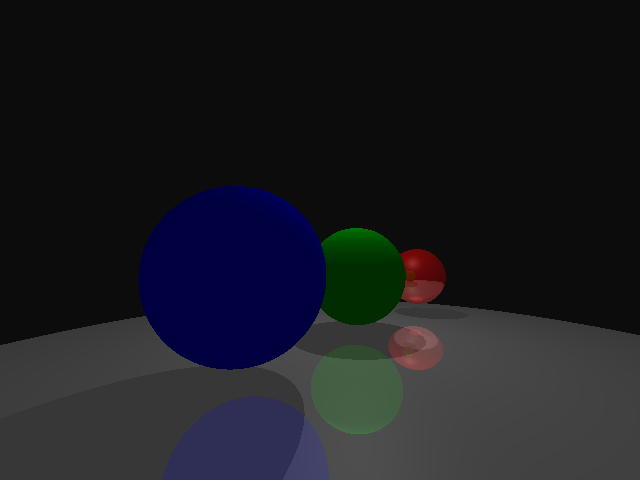



First I implemented ambient lighting:
pub const AmbientLight = struct {
intensity: Vec3,
pub fn illuminate(self: AmbientLight, ray: main.Ray, hit_record: main.HitRecord, scene: *const Scene) Vec3 {
_ = scene;
_ = ray;
return self.intensity * hit_record.material.ambient_color;
}
};
For each pixel, if we hit a sphere, the color of the sphere is the intensity of the ambient light multplied by the ambient color of the sphere. If we don’t hit a sphere we can set the background to the background color.
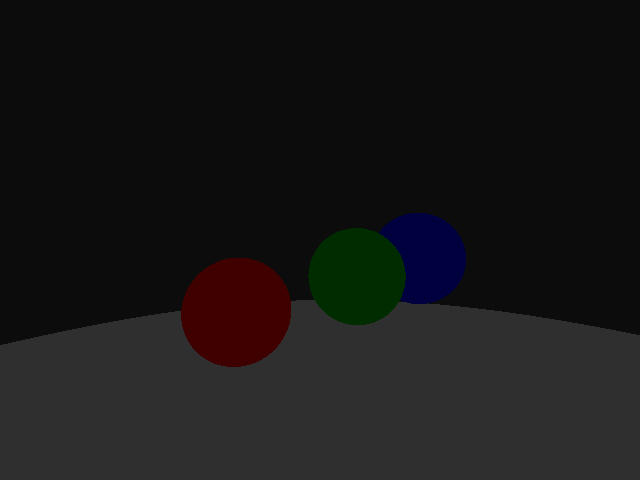
Then I added blinn-phong shading material and point lights.
For a point light the intensity of the light depends on the angle of incidence, the normal of the object, and the distance from the object to the light.
pub const PointLight = struct {
color: Vec3,
loc: Vec3,
pub fn illuminate(self: PointLight, ray: main.Ray, hit_record: main.HitRecord, scene: *const Scene) Vec3 {
_ = scene;
const n = hit_record.surface_normal;
const x = ray.eval(hit_record.distance);
const r = vec3.norm(self.loc - x);
const l = (self.loc - x) / vec3.splat(r);
const E = vec3.splat(@max(0, vec3.dot(n, l))) * self.color / vec3.splat(r * r);
const k = hit_record.material.evaluate(vec3.unit(l), vec3.unit(ray.point - x), n);
return E * k;
}
};
Each sphere contains a Material struct that defines how it interacts with light sources. The evaluate function implements a blinn-phong shading model.
const pi_inv: f64 = 1.0 / std.math.pi;
pub const Material = struct {
ambient_color: Vec3 = Vec3{ 0, 0, 0 },
diffuse_color: Vec3 = Vec3{ 1, 1, 1 },
specular_color: Vec3 = Vec3{ 0, 0, 0 },
specular_coefficient: f64 = 5,
transmissive_color: Vec3 = Vec3{ 0, 0, 0 },
index_of_refraction: f64 = 1,
pub fn evaluate(self: Material, l: Vec3, v: Vec3, n: Vec3) Vec3 {
const h = vec3.unit(l + v);
const diffuse = self.diffuse_color * vec3.splat(pi_inv);
const specular = self.specular_color * vec3.splat(std.math.pow(f64, @max(0, vec3.dot(n, h)), self.specular_coefficient));
return diffuse + specular;
}
}
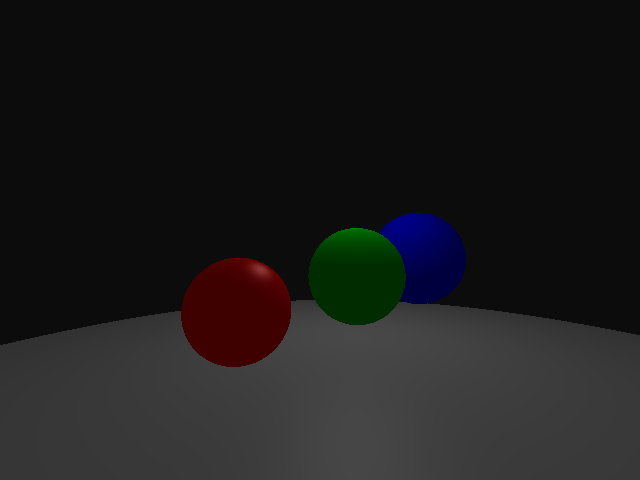
Implementing shadows from here is pretty easy. We can check if reflection ray hits any objects. If it does we are in a shadow and we don’t illumnate.
const srec = scene.hit(.{ .point = x, .dir = l }, 0.002, r);
if (srec != null) {
// we hit an object on the way to the light so we in shadow
return vec3.zero;
} else {
const E = vec3.splat(@max(0, vec3.dot(n, l))) * self.color / vec3.splat(r * r);
const k = hit_record.material.evaluate(vec3.unit(l), vec3.unit(ray.point - x), n);
return E * k;
}
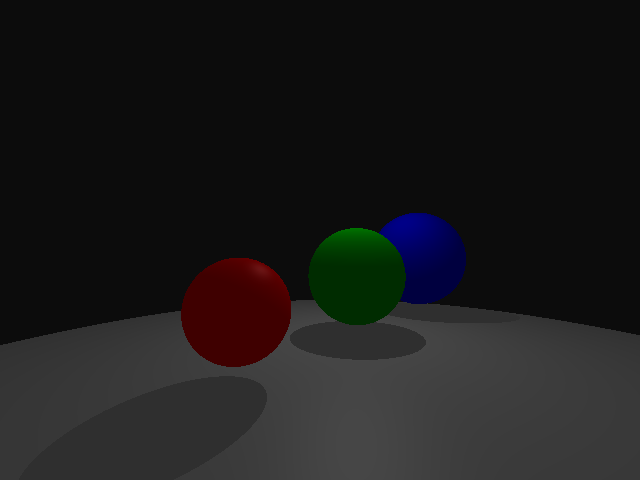
And we can do multiple light sources too by looping over each Light in the scene and adding the result of illuminate to the color.
for (scene.lights.items) |light| {
color += light.illuminate(ray, closest_hit);
}
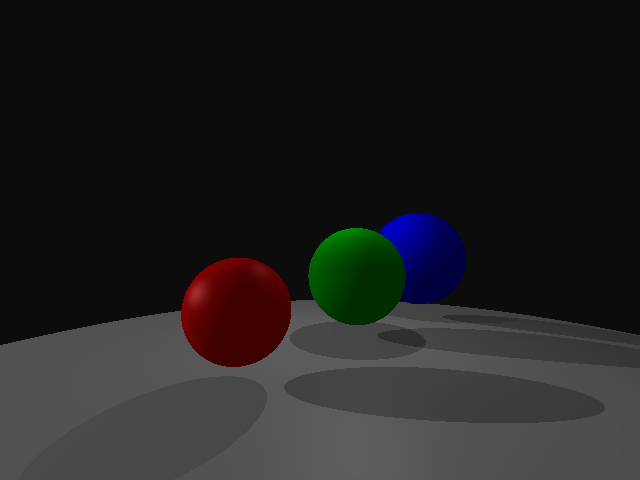
Extra Credit
Directional Lights
Directional lights are like point lights, but their energy doesn’t follow the inverse square law and they emit light in a fixed direction instead of from a point
pub const DirectionalLight = struct {
color: Vec3,
direction: Vec3,
pub fn illuminate(self: DirectionalLight, ray: main.Ray, hit_record: main.HitRecord, scene: *const Scene) Vec3 {
const x = ray.eval(hit_record.distance);
// Here l = -direction where in point light l = vec3.unit(self.loc - x);
const l = vec3.unit(-self.direction);
const n = hit_record.surface_normal;
const srec = scene.hit(.{ .point = x, .dir = -self.direction }, 0.002, std.math.inf(f64));
if (srec != null) {
// we hit an object on the way to the light so we in shadow
return vec3.zero;
} else {
const E = self.color * vec3.splat(@max(0, vec3.dot(n, l)));
const v = vec3.unit(ray.point - x);
// k does not fall of by r*r
const k = hit_record.material.evaluate(vec3.unit(l), v, n);
return E * k;
}
}
}
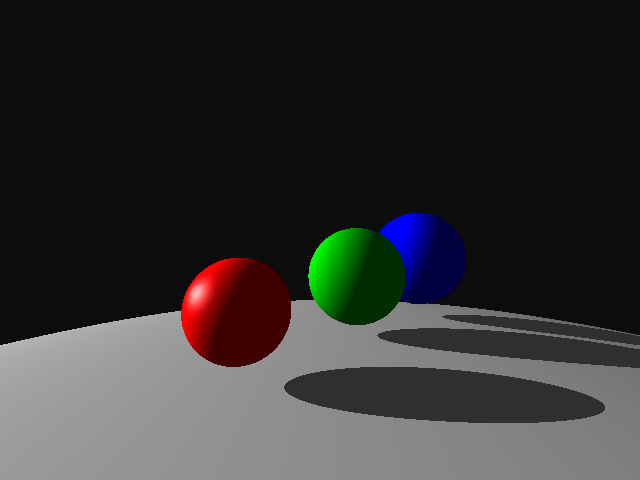
Reflections
To add reflections we can add a recursive call to our shadeRay function.
pub fn shadeRay(self: Scene, ray: main.Ray, bounces: u16) Vec3 {
const hit_obj: ?main.HitRecord = self.hit(ray, 0, std.math.inf(f64));
var color: Vec3 = self.background;
// we got a hit
if (hit_obj != null) {
color = vec3.zero;
for (self.lights.items) |light| {
// Reflect
color += light.illuminate(ray, hit_obj.?, &self);
if (bounces > 0) {
const n = hit_obj.?.surface_normal;
const reflection = ray.dir - vec3.splat(2 * vec3.dot(ray.dir, n)) * n;
// bounce_point + eps * normal
const p = ray.eval(hit_obj.?.distance) + n * vec3.splat(0.001);
// Recurse adding on the reflected ray
color += hit_obj.?.material.specular_color * self.shadeRay(.{ .dir = reflection, .point = p }, bounces - 1);
}
}
}
return color;
}
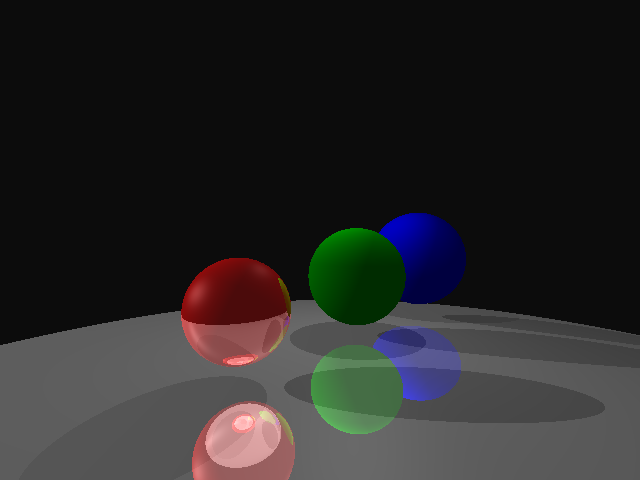
Code
The code requires zig version 0.15.1 or greater and can be compiled with zig build -Doptimize=ReleaseFast
Then the executable can be run with ./zig-out/bin/project_3a MyScenes/camera_pos.txt
Additional Scenes
